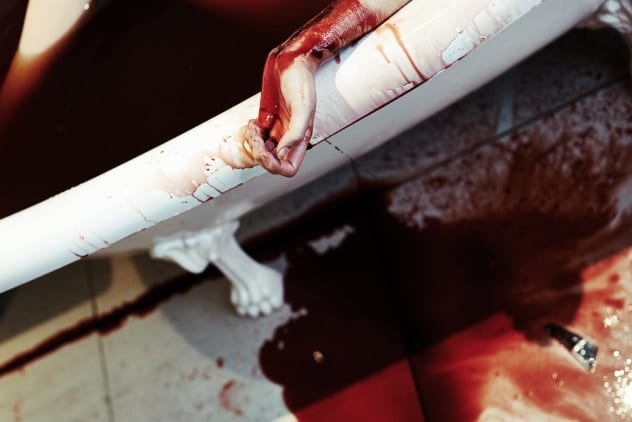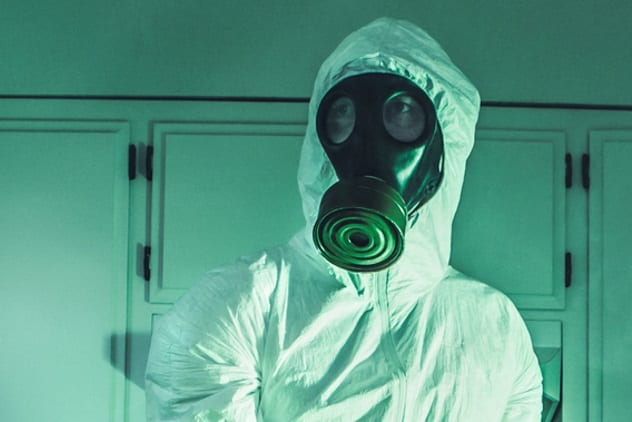 Mysteries
Mysteries  Mysteries
Mysteries  History
History 10 Surprising Stories About the Texas Rangers
 Humans
Humans 10 Philosophers Who Were Driven Mad by Their Own Theories
 Miscellaneous
Miscellaneous 10 Video-Game-Worthy Weapons and Armors from History
 Weird Stuff
Weird Stuff 10 Psychics Who Accurately Predicted Wartime Events
 The Arts
The Arts 10 Pieces of Art Inspired by a Broken Heart
 Health
Health 10 Science Fiction-Sounding New Medical Treatments
 History
History 10 Surprising Facts About the Father of Submarine Warfare
 Space
Space Ten Astonishing New Insights into Alien Worlds
 Weird Stuff
Weird Stuff 10 Bizarre Summer Solstice Rituals Still Practiced Today
 Mysteries
Mysteries Top 10 Haunting Facts About the Ghost Ship MV Alta
 History
History 10 Surprising Stories About the Texas Rangers
 Humans
Humans 10 Philosophers Who Were Driven Mad by Their Own Theories
Who's Behind Listverse?

Jamie Frater
Head Editor
Jamie founded Listverse due to an insatiable desire to share fascinating, obscure, and bizarre facts. He has been a guest speaker on numerous national radio and television stations and is a five time published author.
More About Us Miscellaneous
Miscellaneous 10 Video-Game-Worthy Weapons and Armors from History
 Weird Stuff
Weird Stuff 10 Psychics Who Accurately Predicted Wartime Events
 The Arts
The Arts 10 Pieces of Art Inspired by a Broken Heart
 Health
Health 10 Science Fiction-Sounding New Medical Treatments
 History
History 10 Surprising Facts About the Father of Submarine Warfare
 Space
Space Ten Astonishing New Insights into Alien Worlds
 Weird Stuff
Weird Stuff 10 Bizarre Summer Solstice Rituals Still Practiced Today
10 Gruesome Facts About Suicide And Death Cleanup
When it comes to choosing a profession, most people pick jobs which are not only comfortable but also ones where they don’t have to deal with too many people. When people do enjoy working with the general public, they tend to prefer to work with the living rather than the dead. But there are some professions which are more obscured from view, both by our society and our own fears of our own mortality.
These professions include things like mortuary science, embalming, forensics pathology, medical examiners, and other occupations that deal with the dead. Plenty of crime shows cover the individuals who aid in catching killers or determining the cause of death, but rarely do we think about those charged with cleaning up the dead, and somebody’s got to do it. Here are ten facts about the gruesome process of suicide and death cleanup, because the dead can’t clean up after themselves.
10 Professionals

There is a high amount of professionalism in the field of death and suicide trauma cleanup, which is understandable, considering that most property owners don’t want to clean up after their tenants or others who may have died in their establishments or homes, and that’s where trained groups of professionals come in. But beyond just cleaning up after death, many of these companies specialize in cleaning up after other sorts of traumatic events, such as burglary or vandalism. This diversifies the portfolio of such professionals, whose jobs all too often consist of scraping human or animal brain matter off of a wall or shower.
Many franchises have sprung up around the thriving industry of people who are willing to clean up others’ most gruesome messes for them, and franchisees can buy into companies that specialize in the cleaning up of corpses—and more.[1] The industry is booming as people become more and more hygienic and less interested in removing the dead, something people in years past just accepted as a fact of life.
Suicide and trauma cleanup specialists need to comply with many standards in many places, including licensing, certifications, and environmental rules. A lot of safety is on the line, and these specialists need to maintain a professional attitude during the most gruesome of tasks.
9 Suicide

When it comes to cleaning up scenes of death, suicide is the most pure scene one can tackle. These deathscapes are the least touched by investigators, as detectives and police are generally able to identify a suicide easily, and they collect the least amount of evidence, if any, for future use. When a homicide occurs, it becomes a crime scene, and the cleaning crew picks up what the investigators don’t.
There is another reason that the business of dead body cleanup is thriving in the United States and elsewhere in the developed world: Suicide is on the rise. According to the Centers for Disease Control, suicide rates have risen over 25 percent in the United States since 1999, which is an astonishing rate of people taking their lives. Suicide is a massive contributing factor to the decrease in US life expectancy as well as the death rate, which recently went up for the first time in ages from 2014 to 2016. More deaths equals more bodies, which inevitably equals more business.
With suicides rising sharply, the need for suicide cleanup in particular has become increasingly vital. With an average of 113 suicides taking place every single day in the US alone, that makes for a lot of deathscapes that need to be cleaned up.[2]
8 Unattended Death

Unattended death is another form of messy cleanup service that these companies offer. An unattended death is the death of a friend or loved one that took place when no one else was around.[3] Types of unattended deaths include suicide but also more broadly include homicide, diseases, and natural causes, as well as things like falls and accidental deaths.
The cleanup of unattended deaths differs depending on the type of fatality that takes place. The two types of unattended deaths are traumatic, as in accidents or murders, and nontraumatic, as in a heart attack in one’s sleep. Traumatic deaths result in the cleanup of the bodily materials and parts which are spilled or otherwise spread at the location, though nontraumatic deaths present their own challenges for those charged with the macabre task of cleaning up after the dead.
Even those who didn’t die from traumatic events still decay, so special care and precaution needs to be observed, depending on how far along in the process of decomposition the body is in. Over time, the internal organs of a dead human body liquefy, and as maggots, bacteria, and other forms of life eat away at the flesh, those liquids spill out, and the body slowly begins to melt into its final, putrefied form.
7 Blood

How do you get blood out of stone? The answer is a blend of talc and diluted ammonia. The role of blood is a particularly big issue with these cleanup crews, as blood tends to seep into and stain virtually anything and everything it comes into contact with.[4] This doesn’t even require a death to take place, just a massive injury, like perhaps an open wound someone incurs while swimming, which leads to a massive loss of blood in the pool. What do you do then? Well, obviously the pool needs to be drained, but it also needs to be cleaned in a particular way so that all residual blood is removed from the actual pool structure itself.
Another concern is the possible infections that blood presents, and the list of blood-borne pathogens is quite a terrifying one, making the task of cleaning up every possible drop of blood quite tedious. While for minor instances, a little all-purpose cleaner and a rag may do the job, for major injuries that result in significant blood loss, professionals might be necessary.
6 Hazard

The tools and technologies employed to clean up bloody, gruesome scenes of death are nothing short of what you would see in a movie where an insane virus breaks out and populates the Earth. Workers take extra special care to assure that both they as well as the surrounding areas aren’t contaminated with any biological materials which have been left at a scene. Oftentimes, hazardous materials need to be transported with extreme care and attention to detail, lest they cause injury or sickness in other people.
The necessary requirements for this process are actually quite lengthy in most jurisdictions. One might need a license to transport hazardous materials, for instance, as well as a medical waste permit, and there are even trauma scene practitioner permits, which allow one to physically work at a location where someone has died.[5] This is all to prevent someone with no knowledge of the dangers of pathogens and other hazardous materials from showing up and handling them irresponsibly. The process can be extremely dangerous, and thus professionalism is of vital importance.
This makes sense, as tattoo artists, who come into contact with significantly less bodily material that may be hazardous, also have to go through licensing to demonstrate that they understand the nature of blood-borne pathogens and such before they can start practicing their craft. Sometimes, poisons are used as a method of suicide or homicide, and this needs to be handled by trained professionals who know how to remove and dispose of such materials properly.
5 Restoration

One thing that might surprise you about death and suicide scene cleanup is that bodies aren’t the only focal point of the job. After a homicide or suicide, a complete restoration of the scene needs to be done so that the people who own or dwell in the property can return to as ordinary of a life as possible, as if the death never occurred at that particular location. The difference between harder and softer, or more or less porous, surfaces needs to be accounted for. Paint touch-ups might be required. Moving furniture around to give access to hard-to-reach areas is another part of the job, as sometimes, the results of a death can spill into places that most people wouldn’t even think of.
Beyond the material aspect of restoration, there’s a psychological aspect in the service as well, much like the mortuary staff who beautify bodies for funerals. Restoration at the place of a death can remove the painful memories for the family members who found the dead person and can also return a location to as close to its original condition as possible before the person died.[6] This is a subtle but very powerful thing. As families and friends try to grieve and move on from the loss of someone, returning to their ordinary, well-ordered lives is vital, and the scenery will always serve as a reminder that someone died there, but it doesn’t have to look like it.
4 Meth Lab Recovery

Many of the skills, licenses, permits, and technologies employed to clean up the deceased have also found their applications in other areas, where one might not think the process of restoring a scene would be the same as the restoration of a deathscape. One service offered by cleanup companies is meth lab recovery, where the professionals responsible for cleaning up after the dead go in and restore a home or building that was used to house a meth lab. The chemicals, like the pathogens found at murder and suicide scenes, are as dangerous as they are volatile and need to be handled with extreme care. The same companies that handle suicide and death cleanup are the ones you call when you need to get rid of (hopefully someone else’s) meth lab.
Furthermore, the potential for explosions if the chemicals are mishandled makes the task of cleaning up a meth lab something that’s best left for trained professionals.[7] The fact is that not all meth producers own their own place, and many landlords rent to tenants, totally unaware that they’ll be producing meth in the home or building that they’ve rented. Sometimes, teams are called to handle both situations at once—when a meth lab explodes or a meth cook is accidentally poisoned while cooking. Some of the chemicals used can cause severe burns, and the technologies which shield those who clean up death scenes also shield them from all the dangers of a meth lab while they restore it to a normal, safe, habitable setting.
3 The Stench

Probably one of the most off-putting parts of the job is obviously the unmistakable stench of death and decay. Beyond the traumatic experience of the events that took place is the simple difficulty that most people have in cleaning up a scene that contains a dead body. This provides a massive barrier to entry to most, who might be rendered sick by just the thought of being in the same room with a smelly, decaying corpse. High-tech equipment that looks like it’s meant for protection from a deadly plague is used to mask the smell.
The stench of death actually tops carefully crafted lists created by scientists of nature’s most disgusting, revolting smell. This is actually for a very good evolutionary reason. When many animals set up a new place to live, they use their scents to find one another and mark territory, not only for competitive reasons but also to help other members of their species locate them, procreate, and share the habitat. Likewise, the unmistakable stench of death is a way for even a dead organism to notify other members of the same species that predators or diseases may be lurking near.[8] The complete revulsion we feel when we smell death is actually hardwired into our biological mechanics.
2 Hoarding

Another way the companies we’ve been discussing make ends meet isn’t particularly macabre or death-related but is still quite gruesome, and that’s the process of cleaning up after compulsive hoarders. While, at least initially, we think of cleaning up after hoarders for much of what it actually is, the simple removal of junk and debris from a scene where someone had been living with their material possessions for entirely too long, there’s much more to the story than that. The very nature of having portions of one’s dwelling inaccessible lends itself to some pretty brutal, smelly, dangerous, and even deadly pathogens, such as bacteria and mold, which can cause some pretty severe health problems.[9]
Sometimes, homes and even whole buildings need to be evacuated while the cleanup crews come in and clear the area of any dangerous microbes, restoring the dwelling to a place that’s safely habitable for human existence. Other dangerous things that might be hiding in a place that hasn’t been very well-checked, such as the house of a compulsive hoarder, are asbestos and chemical substances that can cause harm to the human body. These crews, though invisible to the society at large, do a great service in the removal of such dangers so that we can go on about our lives.
1 Money

Most people don’t think of the expense that will be involved when they lose a friend or family member in a home they either own or are renting but are still obliged to pay for the costs incurred resulting from the death. While the state often sends in investigators and police to establish the cause of death, see if the area needs to be marked off as a crime scene and further investigated, and remove the body to bring it to the area medical examiner’s office in the event of a homicide, after the initial investigation is conducted, the bereaved are often the ones left with the responsibility for paying for the cleanup.
The services include the restoration already mentioned, sometimes the removal of the body, the cleaning up of any blood or dangerous materials from the site, and a complete disinfecting of the scene—and all of this can cost a pretty penny. These services don’t come cheap, and many of these companies are family businesses, by the very nature of their obscurity in society, passed on from one generation to the next. These professionals have to put their revulsion aside and scrape hardened brain matter off of shower tile or remove a crusty intestine from a hardwood floor. The price for such gruesome services can be thousands of dollars.[10]
But this proves the highly valuable nature of this line of work, as most people wouldn’t want to clean up and carry the dead bodies of their relatives off to the morgue. It’s much easier and better for the grieving process to hire a team of professionals, willing and able to deal with the brunt of the most gruesome scenes one can find.
I like to write about dark stuff, horror, death, and murder—plus the weird and unusual.
Read more about activities that occur after someone dies on 10 Unusual Death Rituals From Around The World and 10 Bizarre Funeral Customs From Around The World.








